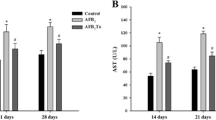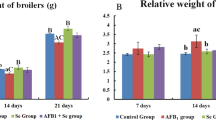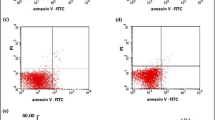Abstract
Aflatoxin B1 (AFB1) is a mycotoxin that causes cytotoxicity through oxidative damage to its target organs. The liver is the first target of AFB1 damage. The aim of this study was to evaluate the protective effect of selenium on AFB1-induced hepatic mitochondrial damage in ducklings using molecular biological and histopathological techniques. Aflatoxin was administered via intragastric intubation (0.1 mg/kg body weight), daily for 21 days. The experimental group also received intragastric sodium selenite (1 mg/kg body weight), while the control group was given the same volume of dimethyl sulfoxide (DMSO). Sequence analysis of the mitochondrial DNA D-loop region showed that AFB1 induced damage. All AFB1-administrated ducklings were identified as having D-loop mitochondrial DNA mutations. Mutations were detected in two ducklings that had received both AFB1 and selenium. Mitochondrial swelling assays showed that opening of the mitochondrial permeability transition pores was increased in ducklings that had received AFB1 for 14 and 21 days (P < 0.05). Selenium significantly attenuated these adverse effects of AFB1. After AFB1 exposure, histological alterations were observed, including fat necrosis, steatosis, and formation of lymphoid nodules with infiltrated lymphocytes. These histological abnormalities were also attenuated by treatment with selenium. The overall data indicated that selenium exerts a potent protective effect against AFB1-induced hepatic mitochondrial damage, possibly through its antioxidant activity.



Similar content being viewed by others
References
Wilson DM, Payne GA (1994) Factors affecting Aspergillus flavus group infection and aflatoxin contamination of crops. In: Eaton DL, Groopman JD (eds) The toxicology of aflatoxins, 1st edn. Academic, San Diego, pp 123–145
Towner RA, Mason RP, Reinke LA (2002) In vivo detection of aflatoxin-induced lipid free radicals in rat bile. Biochim Biophys Acta 1573:55–62
Gesing A, Karbownik-Lewinska M (2008) Protective effects of melatonin and N acetylserotonin on aflatoxin B1-induced lipid peroxidation in rats. Cell Biochem Funct 26:314–319
Yener Z, Celik I (2009) Effects of Urtica dioica L. seed on lipid peroxidation, antioxidants and liver pathology in aflatoxin-induced tissue injury in rats. Food Chem Toxicol 47:418–424
Bedard LL, Massey TE (2006) Aflatoxin B1-induced DNA damage and its repair. Cancer Lett 241(2):174–183
Rastogi R, Srivastava AK (2001) Long term effect of aflatoxin B(1) on lipid peroxidation in rat liver and kidney: effect of picroliv and silymarin. Phytother Res 15:307–310
Panza VS, Wazlawik E, Ricardo Schütz G, Comin L, Hecht KC, da Silva EL (2008) Consumption of green tea favorably affects oxidative stress markers in weight-trained men. Nutrition 24:433–442
Koohi MK, Shahroozian E, Ghazi-Khansari M, Daraei B, Javaheri A, Moghadam-Jafari A, Sadeghi Hashjin G (2011) The effects of pentoxifylline on aflatoxin B1-induced oxidative damage in perfused rat liver. Int J Vet Res 5:43–47
Rayman MP (2000) The importance of selenium to human health. Lancet 356:233–241
Chen K, Shu G, Peng X, Fang J, Cui H, Chen J, Wang F, Chen Z, Zuo Z, Deng J, Geng Y, Lai W (2013) Protective role of sodium selenite on histopathological lesions, decreased T-cell subsets and increased apoptosis of thymus in broilers intoxicated with aflatoxin B1. Food Chem Toxicol 59:446–454
Shi DY, Guo SN, Liao SQ, Su RS, Guo MS, Liu N, Li PF, Tang ZX (2012) Protection of selenium on hepatic mitochondrial respiratory control ratio and respiratory chain complex activities in ducklings intoxicated with aflatoxin B1. Biol Trace Elem Res 145:312–317
Shi DY, Guo SN, Liao SQ, Su RS, Pan JQ, Lin Y, Tang ZX (2012) Influence of selenium on hepatic mitochondrial antioxidant capacity in ducklings intoxicated with aflatoxin B1. Biol Trace Elem Res 145:325–329
Tang Z, Iqbal M, Cawthon D (2002) Heart and breast muscle mitochondrial dysfunction in pulmonary hypertension syndrome in broilers (Gallus domesticus). Comp Biochem Physiol-Part A 3:527–540
Rahmani B, Azimi C, Omranipour R, Raoofian R, Zendehdel K, Saee-Rad S, Heidari M (2012) Mutation screening in the mitochondrial D-loop region of tumoral and non-tumoral breast cancer in Iranian patients. Acta Med Iran 50:447–453
Sesso A, Marques MM, Monteiro MM, Schumacher RI, Colquhoun A, Belizário J, Konno SN, Felix TB, Botelho LA, Santos VZ, Da Silva GR, Higuchi Mde L, Kawakami JT (2004) Morphology of mitochondrial permeability transition: morphometric volumetry in apoptotic cells. Anat Rec A: Discov Mol Cell Evol Biol 281:1337–1351
Tan DJ, Bai RK, Wong LJC (2002) Comprehensive scanning of somatic mitochondrial DNA mutations in breast cancer. Cancer Res 62:972–976
Miyazono F, Schneider PM, Metzger R, Warnecke-Eberz U, Baldus SE, Dienes HP, Aikou T, Hoelscher AH (2002) Mutations in the mitochondrial DNA D-Loop region occur frequently in adenocarcinoma in Barrett’s esophagus. Oncogene 21:3780–3783
Navaglia F, Basso D, Fogar P, Sperti C, Greco E, Zambon CF, Stranges A, Falda A, Pizzi S, Parenti A, Pedrazzoli S, Plebani M (2006) Mitochondrial DNA D-loop in pancreatic cancer: somatic mutations are epiphenomena while the germline 16519 T variant worsens metabolism and outcome. Am J Clin Pathol 126:593–601
Penta JS, Johnson FM, Wachsman JT, Copeland WC (2001) Mitochondrial DNA in human malignancy. Mutat Res 488:119–133
Van Houten B, Woshner V, Santos JH (2006) Role of mitochondrial DNA in toxic responses to oxidative stress. DNA Repair (Amst) 5:145–152
Xu SW, Yao HD, Zhang J, Zhang ZW, Wang JT, Zhang JL, Jiang ZH (2013) The oxidative damage and disbalance of calcium homeostasis in brain of chicken induced by selenium deficiency. Biol Trace Elem Res 151:225–233
Denli M, Blandon JC, Guynot ME, Salado S, Perez JF (2009) Effects of dietary AflaDetox on performance, serum biochemistry, histopathological changes, and aflatoxin residues in broilers exposed to aflatoxin B(1). Poult Sci 88:1444–1451
Magnoli AP, Monge MP, Miazzo RD, Cavaglieri LR, Magnoli CE, Merkis CI, Cristofolini AL, Dalcero AM, Chiacchiera SM (2011) Effect of low levels of aflatoxin B1 on performance, biochemical parameters, and aflatoxin B1 in broiler liver tissues in the presence of monensin and sodium bentonite. Poult Sci 90:48–58
Li JL, Jiang CY, Li S, Xu SW (2013) Cadmium induced hepatotoxicity in chickens (Gallus domesticus) and ameliorative effect by selenium. Ecotoxicol Environ Saf 96:103–109
Kokoszka JE, Coskun P, Esposito LA, Wallace DC (2001) Increased mitochondrial oxidative stress in the Sod2 (+/−) mouse results in the age-related decline of mitochondrial function culminating in increased apoptosis. Proc Natl Acad Sci U S A 98:2278–2283
Cao XH, Zhao SS, Liu DY, Wang Z, Niu LL, Hou LH, Wang CL (2011) ROS-Ca(2+) is associated with mitochondria permeability transition pore involved in surfactin-induced MCF-7 cells apoptosis. Chem Biol Interact 190:16–27
Acknowledgments
This work was supported by the National Natural Science Foundation of China (Grant No. 31302087), National Twelve-Five Technological Supported Plan of China (No. 2011BAD34B01), Science and Technology Plan Projects of Guangdong Province (No. 2012B091100482, 2012B091100034), and NSF grant of Guangdong province (No. S2013040015220).
Author information
Authors and Affiliations
Corresponding author
Additional information
Dayou Shi and Shenquan Liao contributed equally to this work.
Rights and permissions
About this article
Cite this article
Shi, D., Liao, S., Guo, S. et al. Protective Effects of Selenium on Aflatoxin B1-induced Mitochondrial Permeability Transition, DNA Damage, and Histological Alterations in Duckling Liver. Biol Trace Elem Res 163, 162–168 (2015). https://doi.org/10.1007/s12011-014-0189-z
Received:
Accepted:
Published:
Issue Date:
DOI: https://doi.org/10.1007/s12011-014-0189-z




